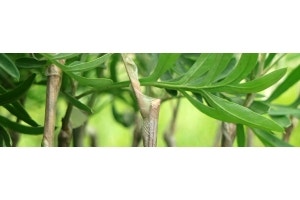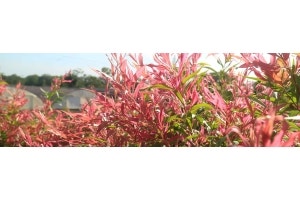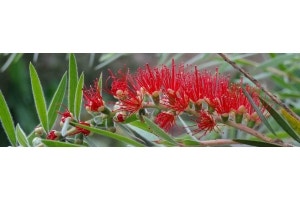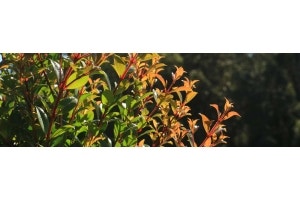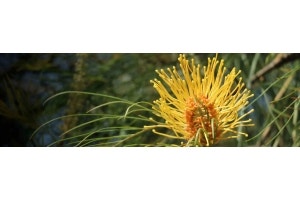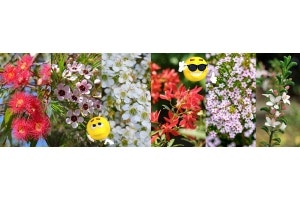
Which Flowering Hedge is Best For You?
Flowering hedges are ideal for creating privacy in the garden, with the bonus of bright flowers to liven things up!Flowering hedges may be clipped neatly in formal gardens, or left to grow for a wilder rustic feel.
Whenever you plant a hedge there's a few questions you need to ask yourself:
- Do you want to do a lot of clipping to keep it in shape? If not, choose a naturally compact and dense-growing plant, one that matures to your ideal preferred height.
- Do you want flowers for a long season? A mixed hedge might be the solution, with several varieties - or even different plant types - blended together.
- Do you spend time out in the garden? A scented hedge would give you extra pleasure while you sit and relax (or weed the borders...)
Here's some of our favourites:

Winter Colour
It's uplifting to see colour about the garden in the midst of a long cold winter. Camellias are one of the earliest shrubs to flower, in shades of white, pink, and red; and their evergreen glossy foliage provides a welcome backdrop while other plants are asleep. Sasanqua camellias are more heat- and humidity-tolerant and flower best in full sun, ideal choices for QLD and coastal NSW. Japonica camellias like it a little cooler and out of hot afternoon sun (though sheltered if possible); perfect picks for VIC and SA gardens.We have both kinds in our range, as well as other species and hybrids, to give you the best of both worlds.

Tropical Blooms
Regularly pruned and maintained Hibiscus make dense flowering hedges full of colourful showy blooms; and they love warm climates. The big vibrant flowers and lush foliage create a relaxed tropical vibe in any frost-free garden space. For very dry areas, plant in shade or semi-shade, and water generously and regularly. Some hibiscus can reach the height of small trees, left to their own devices. Clip them to a manageable height.A prune after flowering will encourage dense growth and more of those bright flowers for you next season.
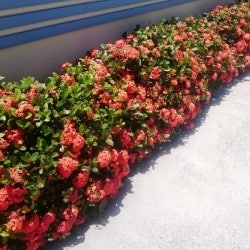 Pair tropical hibiscus with a hedge of brightly flowering lower-growing Ixora. Some ixora varieties will only get to knee height which makes them perfect stepover hedge plants, for delineating a garden space without blocking light or views. Glossy evergreen foliage, glowing new leaf colour, and fat clusters of bright flowers over several months will give you plenty to look at all year round in a frost-free subtropical climate. If you need a taller hedge, we have ixora varieties that can do that for you too.
Pair tropical hibiscus with a hedge of brightly flowering lower-growing Ixora. Some ixora varieties will only get to knee height which makes them perfect stepover hedge plants, for delineating a garden space without blocking light or views. Glossy evergreen foliage, glowing new leaf colour, and fat clusters of bright flowers over several months will give you plenty to look at all year round in a frost-free subtropical climate. If you need a taller hedge, we have ixora varieties that can do that for you too.Ixora make good hedge companions with the similar-looking taller Rondeletia - also flowering with big clusters of bright blooms, and enjoying the warm humidity.A mixed hedge of hibiscus, ixora, and rondeletia will give you a long season of flowering colour in a subtropical climate. You can choose all-red, all-pink, all-white - or mix it up!
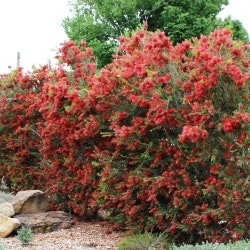
Native Favourites
Callistemon - bottlebrushes - are extremely hardy once established and are known to survive weeks of floodwater followed by months of drought.
(OK, the might look bedraggled afterwards but they survived, and that's what counts!) Most bottlebrush varieties are tolerant of light frost once established, and they all will lure in those native nectar-feeding birds with pink, white, red, or purple blossoms. A standout for small spaces is Slim™. It creates a tall dense screen and flowers profusely with red brushes over a long season.
As the name suggests, it has a narrow growth habit, ideal along pathways and driveway edges, and in small suburban plots where space is tight.
 If you love our native shrubs and don't mind a less-than-perfectly-square hedge, Geraldton waxflowers (Chamelaucium) are a great choice. Like bottlebrushes, they come in a range of pink-purple-white shades, and are showstopping in full flower (usually late winter-early spring, depending on variety and climate). If you have poor sandy soil they won't mind at all, they'll probably prefer it; and they'll screen off your garden space to over head-height. Mature full-grown waxflower bushes are wide and open, so plant them with enough room to grow out as well as up.
If you love our native shrubs and don't mind a less-than-perfectly-square hedge, Geraldton waxflowers (Chamelaucium) are a great choice. Like bottlebrushes, they come in a range of pink-purple-white shades, and are showstopping in full flower (usually late winter-early spring, depending on variety and climate). If you have poor sandy soil they won't mind at all, they'll probably prefer it; and they'll screen off your garden space to over head-height. Mature full-grown waxflower bushes are wide and open, so plant them with enough room to grow out as well as up.For a smaller hedge, purple native mint (Prostanthera looks right at home in a cottage garden, and the white Ballerina variety is very showy in full flower.
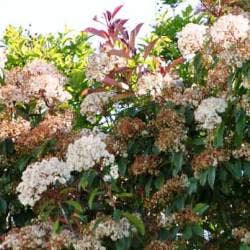
Traditional With a Twist
Some of the most popular green hedges can surprise you and burst into flower, if you don't clip them for a season or two! Viburnum tinus is perfect when you need a hedge in a hurry. It establishes quickly with dense foliage, and large clusters of pink winter buds opening to white spring flowers. The flowers are often followed up with bright berries - tasty snacks for the birds, and a visual treat for you too.
Photinia hedges are often clipped regularly to encourage their red new leaves; but leave them alone and you'll be rewarded with fluffy while flower clusters in abundance - like those here. Pollinators love them!
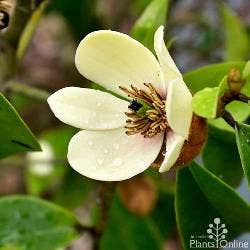
Sweet Scent
Catching the elusive scent of a flower on the warm breeze is one of the sensual pleasures of gardening. Port wine magnolia (Michelia) has a sweet fragrance that reminds some people of port, some of bananas, and some of bubblegum! It's a tall dense evergreen shrub with neat glossy foliage that responds well to pruning, creating a privacy hedge with style and scent. There's Michelia varieties with small discreet flowers, if you prefer the all-green hedging look; and ones with bigger bolder creamy-white flowers, if you want to put on a seasonal show.
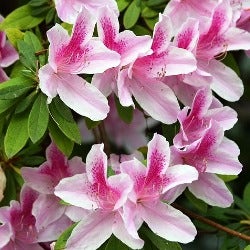
Shade Lovers
You can't go past an Azalea for hedging flowers in shade, and the wide range of flower colours - white, pink, coral, red, purple - means there's at least one that would look perfect in your garden. Azaleas thrive in rich, well-drained soil; as they have a shallow root system, regular watering is a must during the dry season. There are tougher new hybrids available which are more drought tolerant and lace bug resistant than old varieties. The heat-tolerant Encore range will tolerate a wider temperature span (both hot and cold), and will flower more than once in the year. If your favourite old azalea is affected by lace bug, a natural organic pesticide like eco-neem will stop bugs in their tracks.
Regular watering with seaweed fertiliser will make them less susceptible to attack, by keeping your hedges in good health.

























